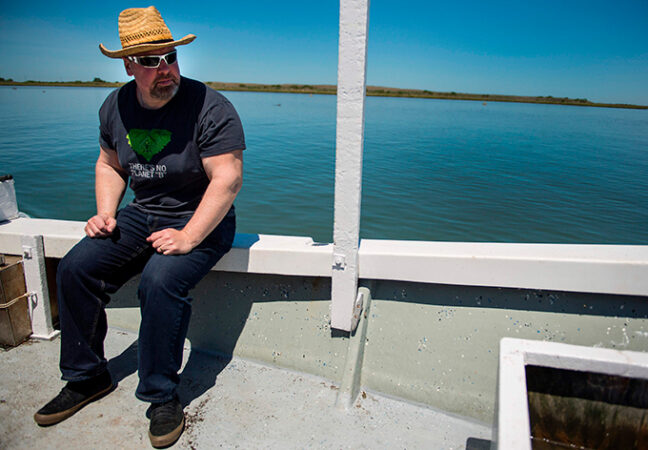Virginia’s Tangier Island is rapidly disappearing. Rising sea levels are exacerbating erosion and flooding, and could make the speck of land in the Chesapeake Bay uninhabitable within the next few decades. For years, island residents, policy makers and others have debated whether to attempt to save the island or relocate its small community elsewhere. But time to decide is running out, says David Schulte, a marine biologist with the U.S. Army Corps of Engineers.
Crucially, that choice will signal how other groups most at risk from climate change, “which are often Native American, minority or low-income such as the isolated fishing community of Tangier, will have their needs addressed — or ignored,” Schulte and his colleague Zehao Wu write in a new study.
The island’s sole town, Tangier, is located on three upland ridges that have largely been protected from coastal erosion. By analyzing aerial photographs of the area from 1967 to 2019, Schulte and Wu, a field researcher at Biogenic Solutions Consulting in Newport News, Va., found that nearly 62 percent of the ridges have been lost to sea level rise. What’s left will convert completely to a wetland by 2051 — about a decade earlier than previously thought — the researchers report November 8 in Frontiers in Climate.
 An analysis by Zehao Wu (shown), a field researcher at Biogenic Solutions Consulting in Newport News, Va., and marine biologist David Schulte suggests that Virginia’s Tangier Island — home to a small fishing community — will completely convert to wetlands by 2051.Z. Wu
An analysis by Zehao Wu (shown), a field researcher at Biogenic Solutions Consulting in Newport News, Va., and marine biologist David Schulte suggests that Virginia’s Tangier Island — home to a small fishing community — will completely convert to wetlands by 2051.Z. Wu
Already, frequent flooding has turned the front yards of many Tangier homes into marshland, Schulte says. Empty parking lots and elevated homes, schools and sidewalks “are all signs of just how bad it is out there.”
Just 436 people lived on the island as of 2020, and that number could drop to zero by 2053, Schulte and Wu’s analysis of population trends suggests. Many factors, including fewer employment opportunities, play a role in the island’s population decline, the researchers say. The shrinking area of dry land has probably convinced people to leave as well.
Protecting and restoring Tangier Island might persuade some residents to stay, but it comes with a hefty price tag: between $250 million to $350 million, Schulte and Wu estimate. That money would fund a medley of interventions, including installing stone along the shoreline to fight erosion and raising the upland ridges by 3 meters using sand from the Chesapeake Bay. Moving a cubic meter of sand from the bottom of the bay to the island costs about $20. Considering the amount of sand needed to raise the ridges, “it gets very expensive really quick,” Schulte says.

Sign Up For the Latest from Science News
Headlines and summaries of the latest Science News articles, delivered to your inbox
Client key* E-mail Address* Go
Thank you for signing up!
There was a problem signing you up.
Relocating Tangier residents is about $150 million cheaper, the researchers calculate. That estimate is based on others from the Corps and the U.S. Government Accountability Office to relocate U.S. coastal communities such as the towns of Shishmaref, Kivalina and Newtok in Alaska, the Quinault Indian Nation village of Taholah in Washington and Isle de Jean Charles in Louisiana.
But moving a town requires more than finding a place for residents to live, Schulte says. Infrastructure such as schools, medical facilities, grocery stores and restaurants need to be moved or rebuilt to provide the community with a similar lifestyle. For Tangier, the lack of land access to nearby towns adds to the cost of relocating, which must be done via boat, Schulte says.
 David Schulte, a marine biologist with the U.S. Army Corps of Engineers (shown here in May 2017 offshore Tangier Island in the Chesapeake Bay), has studied how quickly the island may become uninhabitable as sea level rises.JIM WATSON/AFP via Getty Images
David Schulte, a marine biologist with the U.S. Army Corps of Engineers (shown here in May 2017 offshore Tangier Island in the Chesapeake Bay), has studied how quickly the island may become uninhabitable as sea level rises.JIM WATSON/AFP via Getty Images
As the planet warms and oceans swell, an increasing number of other coastal towns and cities in the United States and around the world will probably face a similar choice as Tangier. The cost to save or relocate each one would, of course, differ, Schulte says. Some communities may not be as expensive to move as offshore Tangier, he speculates, but would certainly be in the ballpark.
Sea level rise has been driven, in part, by human activities in bigger cities (SN: 8/9/21). But it is shorelines, often inhabited by Native Americans, minority or low-income communities, that are the first to bear the brunt of this consequence of climate change, Wu notes. That makes it even more essential to draw attention to these overlooked communities, he says.

